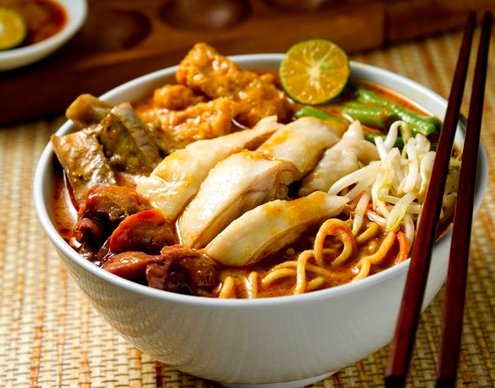
I am in Singapore at least twice a year and on my recent trip, I had the most delicious laksa from a hawker’s stall near the Changi Airport for less than 40 RMB. The street food of Singapore is a food lover’s delight. As a melting pot of cultures and cuisines, Singaporeans take something as simple as noodles and infuse it with wonderful spices such as turmeric, tamarind, chilli and galangal, resulting in a dish that is neither Malay, Indian nor Chinese, but uniquely Singaporean. I love their flavourful beef rendang dish as well as their spicy sambal prawns and asam fish head curry. For these intensely flavoured dishes I reach for wine that are refreshing and vibrant.
Chinese food, with its numerous regional styles and cooking methods, forms the base of Singaporean cuisine. Although Hokkien Singaporeans are the largest group, restaurants that cater just to Hokkien food are limited. The most popular restaurants are Cantonese, considered the most refined Chinese cuisine, followed by a range of regional food such as Sichuan, Shanghainese and Teochew. But even in the most sophisticated Cantonese eateries, the soy sauce with sliced chilli is never far away. Singaporean taste buds, often used to stronger, more robust flavours, will often reach for the soya-chilli or chilli sambal to go with their every meal.
There are numerous Singaporean versions of regional favourites such as Hainanese chicken rice or yong tau foo (beancurd stuffed with minced fish and vegetables). These differ from the original in the greater intensity of flavours – for example, the Singaporean version as opposed to the original Hainan-style dish involves serving hotter chillies and darker, more flavourful soy sauce with the boiled chicken.
Nyonya, a respectful term for Malay women of the upper social classes, is used interchangeably with Peranakan to describe the country’s indigenous cuisine. This wok-based culinary style blends Chinese and Malaysian ingredients and cooking methods. Combinations can include oyster sauce (Chinese influence) with coconut milk and toasted peanuts or belacan (prawn paste) with ginger and garlic. A classic Peranakan dish is otak-otak, a coconut based fish dish, seasoned with galangal, chilli paste and other herbs wrapped in banana leaf and grilled over flames. Restaurants such as Blue Ginger show that Nyonya cuisine can be just as tasty in stylish restaurants as in hawkers’ stalls.
Although Indians make up less than 10% of the population, their long-term presence is felt in their strong influence on food. The majority of Indians in Singapore are Tamils from the southernmost state of India as well as Sri Lanka. Southern Indian-style banana leaf restaurants abound – using banana leaf as the ‘plate’, a pile of rice forms the base and enjoyed with a wide selection of spicy fare. This can include pappadom (thin, crispy wafer), chicken or prawn masala, marinated vegetables and spicy curry dishes. Traditionally, the meal is eaten with hands, but in Singapore, forks and spoons are more often used.
Singaporean cuisine’s bold and intense flavours are a challenge to pair with wine. It is not just the spices and chilli, which can be tongue-numbing, but the combination of these spices along with a barrage of flavours – salty dried shrimps or anchovies, sweetness from coconuts or gula malaka (palm sugar) and sour notes from lime or tamarind. All of these qualities tantalise and delight but often leave little room for wine’s more subtle flavours. However, among Singaporean locals who like to experiment and have an equal passion for wine as well as food, certain combinations have resulted in big smiles and satisfied taste buds.
The generous use of sugar in many dishes means off-dry and medium-sweet wines can work well by acting as a foil for the array of spices and enhance a dish’s sweetness. The cool serving temperature of wines such as German Rieslings, off-dry Alsace whites and Moscato d’Asti gives refreshment value by cooling the mouth, offering firm acidity and at the same time, balancing the spiciness in the food. The wine’s core fruit needs to be vibrant and prominent so that it can match the food’s intensity of flavours. Less fruity wines are good, neutral accompaniments but will not complement or enhance the meal.
Sparkling wines are great refreshing companions to Singaporean food. With spicier food, opt for simpler flavours such as Italian Prosecco, German Sekt or a New World counterpart. When the spices and flavours are not overpowering, a full-bodied style Champagne can work well. White wines with refreshing acidity in an assertive style such as New Zealand Riesling or ripe Sauvignon Blanc (with more passion fruit rather than grassy fruit character) is a good partner to many Peranakan dishes.
Red wine lovers also have a wide variety of options since the richness in many sauces is a good match with fruity red wines with modest tannins. Cool climate red wines possess firm acidity and Pinot Noir is the best option for a wide variety of Singaporean food. New Zealand and cool climate Australian Pinot Noir are excellent choices since the prominent fruit, moderate tannins and fresh acidity offer a nice counterpoint to savoury dishes. High-alcohol, tannic red wines will only work well with a limited range of dishes while low tannin wines such as Gamay (Beaujolais) and Dolcetto, slightly chilled, are good companions to flavourful, spicy dishes.
Reprinted with permission from WINE Guangzhou









